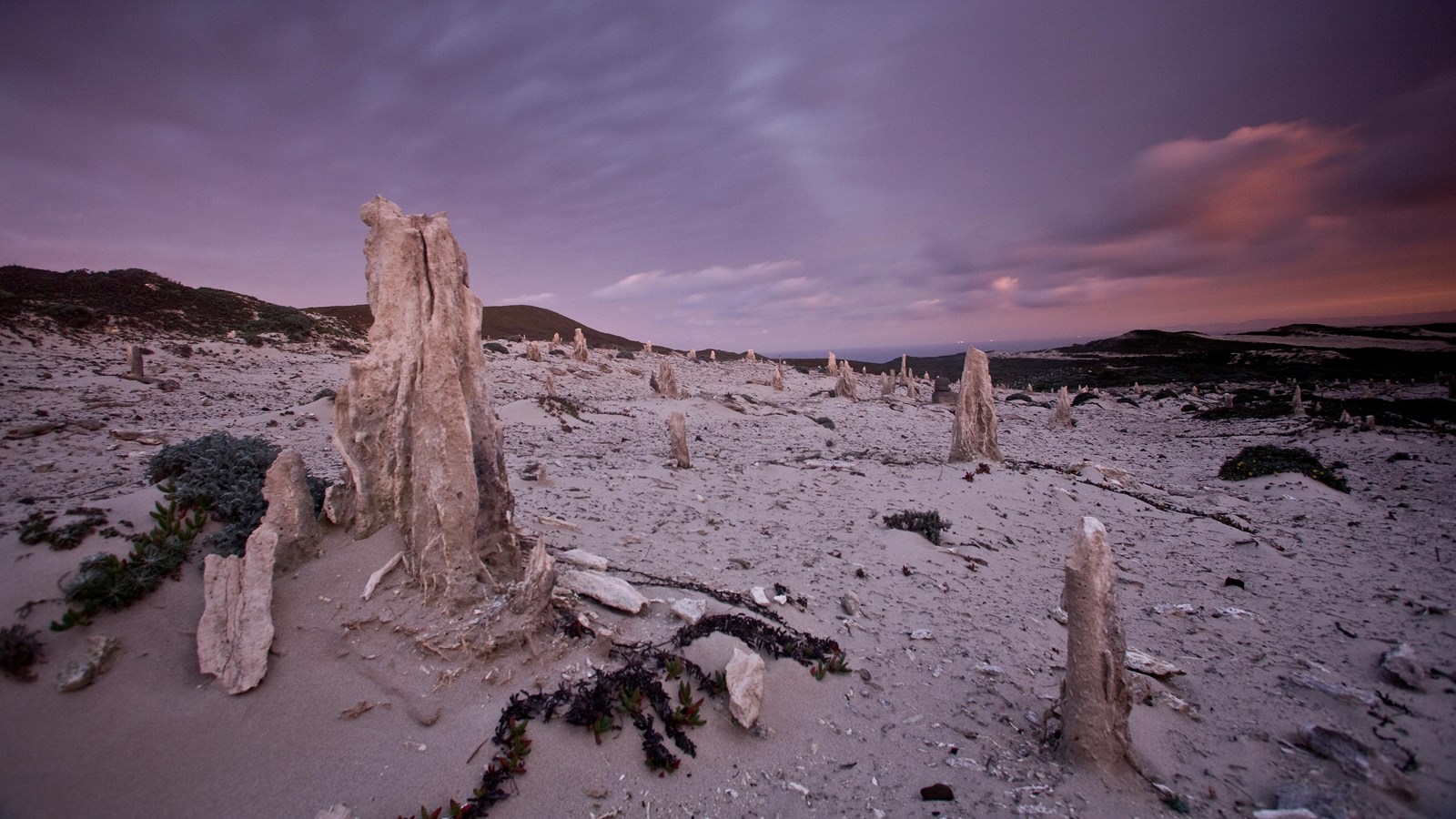Last updated: March 16, 2021
Place
Caliche Forest

Tim Hauf, timhaufphotography.com
Scenic View/Photo Spot
Due to unexploded ordnance, visitors must be accompanied by a ranger to this location. Entering this area without a ranger is a violation of federal law.
The San Miguel Island's isolation has helped to preserve one of the island's most interesting features-the caliche forest, calcified casts of ancient vegetation that have been exposed in several areas by the eroding sand. This ancient fossilized vegetation is comprised of roots and trunks of a variety of plants, including possibly pines and cypresses that once grew on the island during periods of colder and wetter climates. The most unusual casting that has been found is a huge caliche log that was 2½ feet in diameter and about 30 feet long.
Caliche Forest Formation Abridged Version
The formation of this fossilized vegetation occurred when blowing sand apparently overwhelmed and buried the island's vegetation (including the old pines and cypresses) during the fluctuating seas of the last ice age - the Pleistocene (from 11,000 years ago to 1.8 million years ago). As the roots and trunks of these trees decomposed, their molds filled with sand.
Calcium carbonate from shell fragments that were mixed in with the sand were dissolved by rain water, which is naturally slightly acidic. It accumulated below the surface in the sand filled molds and around remaining plant material, cementing together with sand and silt to create caliche.
When the more recent livestock grazing destroyed much of the island's top soil and the strong winds blew away the remaining sandy soil, the caliche forest was revealed. So today, we are treated to a rare glimpse of a landscape turned inside out - the roots and trunks of these ancient plants now stand as "forests."
Caliche Forest Formation Detailed Version
There are two types of caliche present on San Miguel: soil caliche and caliche fossil forests. Soil caliche is found throughout the world in areas with arid climates, particularly where rainfall occurs in amounts less than about 30 inches (San Miguel receives about 16 inches per year). Calcium carbonate, which comes from shell fragments mixed in with blowing sand, is leached from the topsoil and deposited in the subsoil or substrate as a distinct soil layer - often called hardpan. This hard pan was quite evident on the trail we walked on to this overlook.
Caliche fossil forests can be divided up into two different types of caliche - filled root, trunk and stem casts, and hollow root casts or sheaths. Each of these is formed by a somewhat different process.
The stage was set when blowing sand apparently overwhelmed and buried the island's vegetation including old pines and cypresses. This most likely occurred during the last ice age when fluctuating sea levels exposed more sand around the island. It also may have occurred during the transition to a more arid climate beginning about 10-12,000 years ago. Overgrazing by pygmy mammoths probably contributed to the amount of blowing sand as well. As the roots and trunks of these trees decomposed, their molds filled with sand.
Next, you need caliche. Caliche is calcium-carbonate material that is mixed with silt and sand. The calcium carbonate on San Miguel is derived by the dissolving of shells and shell fragments that have been blown across the island by the strong northwest winds. The dissolution of the shells are caused by the weak natural acid found in rain, which is formed by reactions between water vapor and some of the carbon dioxide in the atmosphere.
San Miguel has a semi-arid climate; so when it rains, the volume of water is too small to carry dissolved materials away from the area. So the groundwater dissolves calcium carbonate shells in the surface layer and then re-precipitates it a little lower in the soil profile. As this calcium carbonate solution runs through the soil it is drawn to the sand-filled molds of the decomposed roots and trunks, possibly because they were more porous and provided an easy pathway for the groundwater. Once the calcium carbonate solution enters these sand-filled molds, it cements it together forming a cast of the former root, trunk or stem.
The other type of caliche found in the fossil forests is hollow root casts or sheaths. Although the source of the calcium carbonate is the same as described above, this type of caliche is formed a little differently. The organic acids in living plants' root systems react chemically with the calcium carbonate solution, cementing sand and silt together to form caliche sheaths. After the plants decay, these hollow castings remain. Caliche sheaths are forming now, as we speak, around the living roots of some plants.
These two types of caliche that make up the caliche fossil forests, were then revealed when the more recent livestock grazing destroyed much of the island's top soil and the strong winds blew away the remaining sandy soil.
